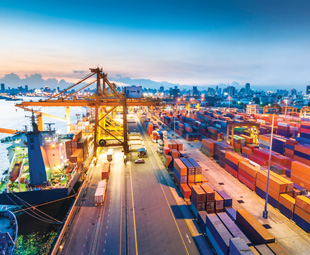The keyword is connectivity

Transport and logistics companies around the world are turning to technology to remain competitive and meet demand. MARISKA MORRIS looks at the new developments in the Middle East
Globally, more transport and logistics companies are looking towards innovations in technology to improve service and productivity and to lower costs. The Middle East is no exception and countries in this region are looking toward cloud-based platforms, apps and even self-driving vehicles to remain competitive.
In July, entrepreneurs from Saudi Arabia and the United Arab Emirates (UAE) launched Trukkin, a business-to-business, cloud-based platform, which is aimed at streamlining logistics between shipping companies and transport providers.
Shippers request a truck via the iOS and Android-supported app, or through the Trukkin web portal, and pick the transport provider they prefer. The order can be tracked in real time through the app, and once it arrives at its destination a proof of delivery is uploaded, which concludes the service. Trucks are also able to see which loads are available.
“We’ve launched Trukkin with the mission of making it the preferred logistics enabler throughout the region,” co-founder and CEO of Trukkin, Janardan Dalmia, says in an article published by Construction Week Online. He adds: “Trukkin answers a genuine industry need for greater transparency, choice of providers and the ability to request transport services from available fleets.”
According to Dalmia, Trukkin makes the registration, ordering and accepting of a bid, as well as the payment process, very simple. He notes: “I am, therefore, extremely confident that Trukkin will enhance and simplify logistics across industries in the whole Gulf Cooperation Council (GCC) region.”
The technology seems similar to that of Uber and Airbnb for good reason, as the app was inspired by similar cloud-based solutions now dominating all industries.
Dalmia says: “Cloud-based app solutions are revolutionising the provision of services from renting holiday homes to hailing cabs. We’ve brought a similar model to the logistics, driving and trucking industries, putting technology at our core to unlock efficiencies.”
While Trukkin streamlines logistics between fleets and shippers, the LogiGate smart app aims to negotiate logistics between warehousing and transportation. The app, which was developed by Dubai Trade earlier this year, has two services: LogiGate Transport and LogiGate Warehousing. Both are accessible via a smartphone or online.
Similar to Trukkin, LogiGate connects cargo owners with transport companies. Goods are tracked via GPS, with an online payment through Dubai Trade’s secure e-Payment gateway, Rosoom, once the delivery has been made. There are also real-time notifications of new job opportunities in the industry.
According to an article published by Technical Review Middle East, the app “will benefit Dubai’s trade and logistics sector by providing speed and accuracy in logistics and supply chain management”.
Dubai Trade hopes to roll out another aspect of LogiGate soon, which will connect warehouse owners and service providers with people seeking storage space for cargo.
Mahmood Al Bastaki, CEO of Dubai Trade, notes: “LogiGate contributes to the development of smart trade in Dubai, allowing for a direct connection between merchants and those with transportation or warehouse capabilities. We anticipate competitive offers and rates that will set new benchmarks for the market.”
Another technology development that will set a new benchmark for the industry is truck platooning. Various trucks are electronically connected with one vehicle leading and others mimicking the acceleration and braking of the first truck.
During a question and answer session with The National, Kivanç Arman, the automotive aftermarket regional director for the Middle East and Turkey at Robert Bosch Middle East, noted the benefits of truck platooning for the transport and logistics sector.
“The trucking industry has a lot of room for improvement through automation and connectedness. At present, a truck driver’s cab has so many switches and levers to control different parts of the vehicle, which are very counter-intuitive and increase the risk for mistakes,” Arman says.
He adds that transport companies would benefit from a simple, easy-to-use driver interface similar to that of a smartphone, which will allow the truck driver to focus on the road. Aside from the benefits that might motivate the introduction of truck platooning, he points out that the large increase in freight will also be a factor.
“A considerable volume of freight is moved by truck in the GCC today. Over one million trucks are currently in operation across the region, and this number increases by five to nine percent every year,” says Arman. He notes that major logistics hubs with many freeways would be well suited for truck platooning.
Arman points out that platooning is not yet common due to its complexity. He says: “It will require at least another five to ten years in order to reach maturity. It requires advanced and reliable inter-vehicle connectivity to ensure that acceleration, braking and steering for each vehicle in the fleet follows that of the first truck in the convoy.”
He comments that all trucks would need to be automated and connected before truck platooning can take place. He predicts that platooning on freeways will be possible by 2025.
“Connectivity is the keyword for the future of the trucking industry, but, just as for automated personal vehicles, legal conditions need to be created to make automated vehicles a reality on the production lines,” Arman concludes.
Published by
Focus on Transport
focusmagsa




